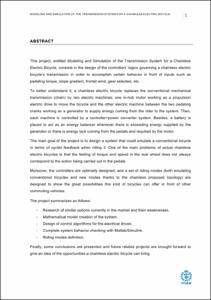Mostra el registre d'ítem simple
Modeling and simulation of the transmission system for a chainless electric bicycle
| dc.contributor | Dòria Cerezo, Arnau |
| dc.contributor.author | Garcia Farreny, Alex |
| dc.contributor.other | Universitat Politècnica de Catalunya. Departament d'Enginyeria Elèctrica |
| dc.date.accessioned | 2015-11-19T17:52:00Z |
| dc.date.available | 2015-11-19T17:52:00Z |
| dc.date.issued | 2015-05 |
| dc.identifier.uri | http://hdl.handle.net/2117/79501 |
| dc.description.abstract | This project, entitled Modeling and Simulation of the Transmission System for a Chainless Electric Bicycle, consists in the design of the controllers’ logics governing a chainless electric bicycle’s transmission in order to accomplish certain behavior in front of inputs such as pedaling torque, slope gradient, frontal wind, gear selected, etc. To better understand it, a chainless electric bicycle replaces the conventional mechanical transmission (chain) by two electric machines; one in-hub motor working as a propulsion electric drive to move the bicycle and the other electric machine between the two pedaling cranks working as a generator to supply energy coming from the rider to the system. Then, each machine is controlled by a controller+power converter system. Besides, a battery is placed to act as an energy balancer whenever there is exceeding energy supplied by the generator or there is energy lack coming from the pedals and required by the motor. The main goal of the project is to design a system that could emulate a conventional bicycle in terms of cyclist feedback when riding it. One of the main problems of actual chainless electric bicycles is that the feeling of torque and speed in the rear wheel does not always correspond to the action being carried out in the pedals. Moreover, the controllers are optimally designed, and a set of riding modes (both emulating conventional bicycles and new modes thanks to the chainless proposed topology) are designed to show the great possibilities this kind of bicycles can offer in front of other commuting vehicles. The project summarizes as follows: - Research of similar options currently in the market and their weaknesses. - Mathematical model creation of the system. - Design of control algorithms for the electrical drives. - Complete system behavior checking with Matlab/Simulink. - Riding modes definition. Finally, some conclusions are presented and future related projects are brought forward to give an idea of the opportunities a chainless electric bicycle can bring. |
| dc.language.iso | eng |
| dc.publisher | Universitat Politècnica de Catalunya |
| dc.rights | Attribution-NonCommercial-NoDerivs 3.0 Spain |
| dc.rights.uri | http://creativecommons.org/licenses/by-nc-nd/3.0/es/ |
| dc.subject | Àrees temàtiques de la UPC::Enginyeria mecànica::Motors::Motors elèctrics |
| dc.subject.lcsh | Electric bicycles -- Design |
| dc.subject.lcsh | Electric power transmission |
| dc.title | Modeling and simulation of the transmission system for a chainless electric bicycle |
| dc.type | Bachelor thesis |
| dc.subject.lemac | Bicicletes elèctriques -- Disseny |
| dc.subject.lemac | Energia elèctrica -- Transmissió |
| dc.rights.access | Open Access |
| dc.audience.educationlevel | Grau |
| dc.audience.mediator | Escola Tècnica Superior d'Enginyeria Industrial de Barcelona |
| dc.audience.degree | GRAU EN ENGINYERIA EN TECNOLOGIES INDUSTRIALS (Pla 2010) |


